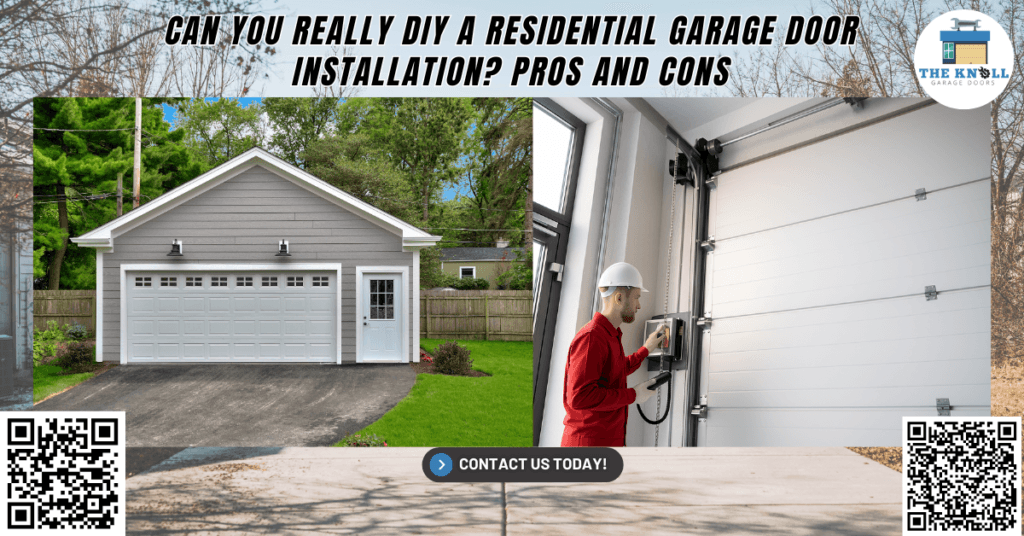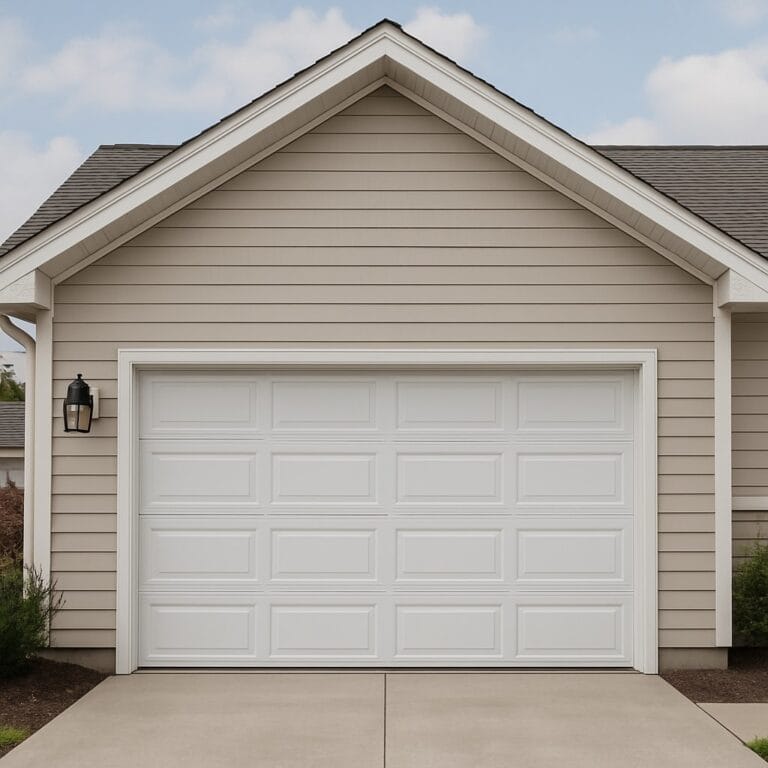Can You Really DIY a Residential Garage Door Installation? Pros and Cons

When Mr. Langston from College Station decided to replace his aging garage door with a sleek, energy-efficient insulated steel model, he initially wanted to do it himself. Armed with a power drill, vise grips, and a YouTube step-by-step guide, he was ready. But halfway through installing the torsion springs, things went south literally. The tension-loaded spring snapped off the torsion tube, damaging the horizontal track and narrowly missing his arm. He called The Knoll Garage Doors the next day to finish the job and fix the costly mistake.
Statistics back up these kinds of risks: the U.S. Consumer Product Safety Commission reports nearly 20,000 annual injuries related to garage doors, with a large portion stemming from incorrect DIY attempts. Installing a garage door might appear simple, just panels, brackets, and bolts, right? But behind every successful garage door installation lies a precise system of components: torsion springs, flag brackets, cables, hinges, vertical tracks, center brackets, and safety sensors, all requiring careful alignment and calibration.
At The Knoll Garage Doors, we specialize in residential garage door installation services that prioritize safety, proper operation, and longevity. With our comprehensive guide below, we’ll explore the pros and cons of doing it yourself vs. hiring professionals like us. From garage door panels to insulation ratings and power tool usage, we’ll walk you through what you need to know before rolling up your sleeves.
What Is a Residential Garage Door Installation?
A residential garage door installation is the process of removing an old door (if applicable) and setting up a new garage door system in a home. It involves multiple technical steps like preparing the garage opening, aligning the tracks, setting the torsion tube, attaching the garage door panels from bottom to top section, securing brackets and hinges, and installing the garage door opener.
In addition to the physical components, you also must consider the r-values of the door (a measure of insulation performance), the type of springs (torsion springs vs. extension springs), and the appropriate materials for your climate; steel, wood composite, aluminum, or insulated vinyl are all popular choices.

A properly installed garage door ensures:
- Smooth operation along both vertical and horizontal tracks
- Safe opening and closing via correctly tensioned garage door springs
- Improved energy efficiency through high-quality insulation and sealing
- Enhanced security via tight locking systems and reinforced brackets
Without correct alignment, bracket placement, or spring tension, your new door may operate unevenly or unsafely. That’s why this isn’t your average weekend project.
Pros of DIY Residential Garage Door Installation
1. Cost Savings on Labor
One of the biggest motivators for a DIY garage door installation is avoiding professional labor fees. Homeowners might save between $200 to $500 depending on local service rates and the complexity of the door system. If you already own some of the necessary tools like a power drill, level, vise grips, and socket wrench set, you’re a step closer to lowering your investment.
However, remember that savings may disappear quickly if a mistake requires repairs or reinstallation.
2. Control Over Timing
With DIY, you can work at your own pace, especially useful if you have a busy schedule. You can start installing brackets and panels after work or finish adjusting the torsion springs over the weekend. You’re not reliant on a technician’s calendar.
But be aware: garage doors are heavy. Each garage door panel may weigh between 40–60 pounds. Working solo can extend installation time and increase the risk of improper assembly.
3. Satisfaction of Doing It Yourself
Installing your garage door can bring a sense of personal accomplishment. For seasoned DIY enthusiasts who have tackled framing, electrical work, or other home improvement projects, the challenge can be rewarding, especially if it’s a basic, non-insulated single-door system.
Still, garage door installation involves detailed alignment of the vertical tracks, anchoring of the torsion spring system, and tensioning cables, tasks not typically found in standard DIY skill sets.
Cons of DIY Residential Garage Door Installation
1. Serious Injury Risks
Garage doors are more dangerous than they appear. The torsion springs, located above the header, are under immense tension and can cause severe injury if mishandled. One wrong twist of the winding bars or misalignment of the spring center bracket could cause springs to recoil with explosive force. Injuries can include broken bones, lacerations, or worse.
Even tasks like securing garage door panels with screws or mounting the flag brackets can be hazardous if the door shifts unexpectedly.
2. Complex, Multi-Step Installation Process
Each component must be installed in the correct order, starting with the bottom panel, attaching hinges, connecting cables to the bottom brackets, installing vertical and horizontal tracks, mounting the torsion tube and springs, then connecting the garage door opener. Any misstep in alignment or torque setting can result in poor operation or long-term damage.
Tasks like drilling into concrete garage walls for track brackets, aligning the opener drive rail, or balancing spring tension are not intuitive.
3. Lack of Proper Tools
Professional installers use industry-grade tools such as:
- Winding bars for torsion spring adjustment
- Laser levels for perfect track alignment
- Heavy-duty vise grips for stabilizing the system during setup
- Torque wrenches to secure bolts and brackets properly
Most homeowners don’t have these tools on hand, leading to shortcuts that could compromise safety and smooth operation.
4. Risk of Voiding Warranties
Many garage door manufacturers require professional installation for warranty validation. If the door is installed incorrectly or breaks due to improper setup, the warranty might not cover replacement parts or repairs.
This includes the garage door opener system, which can be sensitive to misalignment and improper installation.
5. Missing Key Safety Checks
A professional installation includes a comprehensive safety inspection:
- Testing the force setting of the garage door opener
- Ensuring cables are secured and not frayed
- Checking for proper insulation sealing around the panels
- Verifying smooth movement along the garage door tracks
DIY installers often skip these vital steps or don’t know how to check for them, leaving the door at risk of malfunction.
When Does DIY Make Sense?
While we don’t recommend full installations for beginners, there are a few garage door tasks where DIY can be a safe and effective option:
- Replacing weather seals and insulation strips
- Lubricating hinges, rollers, and tracks for routine maintenance
- Tightening loose bolts or brackets during upkeep
- Painting or cleaning garage door panels
But for tasks involving the torsion spring system, garage door opener integration, or realignment of tracks and brackets, it’s best to call a professional garage door service like The Knoll Garage Doors.
Why Professional Installation Is Worth It
✅ Safety Above All
Our technicians are trained to manage high-tension systems like torsion springs, safely install panels and brackets, and align vertical and horizontal tracks for optimal performance.
✅ Comprehensive Installation
We handle the entire process from start to finish, including:
- Removing your old door
- Measuring the garage door opening
- Installing garage door sections and hinges
- Securing the torsion tube, brackets, and cable drums
- Integrating your garage door opener for proper operation
- Sealing and insulating for energy efficiency
✅ Energy Efficiency and Longevity
Professionally installed insulated garage doors help conserve energy, maintain consistent interior temperatures, and boost your home’s R-value, especially important in College Station’s changing seasons.
✅ Boost in Curb Appeal and Property Value
We help you choose the right garage door style and material to match your home’s architecture, enhancing both functionality and aesthetic appeal.
How Can The Knoll Garage Doors Help You?
At The Knoll Garage Doors, we understand that a residential garage door is more than just an entryway; it’s a vital part of your home’s security, energy efficiency, and curb appeal.
That’s why we offer:
- Custom installation services tailored to your home and door type
- Expert handling of torsion springs, brackets, hinges, and insulation
- Smart opener integration for modern security and convenience
- Energy-efficient doors to help you conserve energy and save on bills
- Full safety inspections to ensure smooth and secure operation
With decades of experience in garage door installation and repair, our team serves homeowners throughout College Station and nearby areas. We bring precision, reliability, and a commitment to quality in every project.
📍 Stop by or call us today!
📌 Address: 2322 Texas Ave S, College Station, TX 77840
📞 Phone: (979) 978-0221
Don’t risk your safety or your investment. Let The Knoll Garage Doors deliver a professional, efficient, and worry-free garage door installation. Call now for a free estimate!
Frequently Asked Questions (FAQs)
1. How long does it take to install a residential garage door?
Most professional installations take between 3 to 6 hours, depending on the size and type of the door and whether an old door needs to be removed.
2. Can I reuse my old garage door opener with a new door?
Yes, in many cases you can reuse your existing opener, but it must be compatible with the weight, height, and type of the new garage door.
3. What’s the best type of insulation for garage doors in Texas?
Polyurethane foam insulation offers the highest R-value and energy efficiency, making it ideal for the Texas heat.
4. Does a new garage door add value to my home?
Replacing an old door with a new, modern garage door can increase your home’s curb appeal and yield one of the highest returns on investment for remodeling projects.
